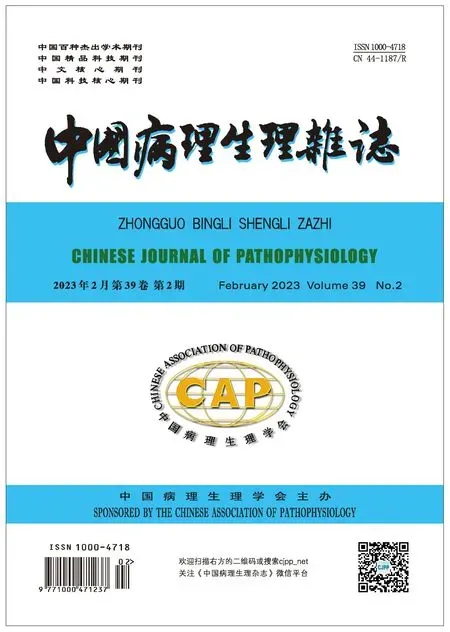炎症微环境中ERN1调节软骨细胞炎症因子的实验研究*
梁利, 邓琳, 罗瑞, 冯乃波, 李小丽, 范梦恬, 郭风劲
炎症微环境中ERN1调节软骨细胞炎症因子的实验研究*
梁利, 邓琳, 罗瑞, 冯乃波, 李小丽, 范梦恬, 郭风劲△
(重庆医科大学基础医学院细胞生物学与遗传学教研室,重庆 400016)
探讨内质网到细胞核信号1(endoplasmic reticulum-to-nucleus signaling 1,)基因对炎症微环境中软骨细胞炎症因子和软骨分解代谢的影响。通过CRISPR-Cas9系统构建人基因敲除的C28/I2软骨细胞株(KO);从C57BL/6J背景的软骨特异性敲除(cKO)小鼠软骨组织分离原代软骨细胞,分别为对照组(flox/flox)、cKO组(flox/flox-Col2Cre+);在C28/I2人正常软骨细胞中过表达腺病毒(Ad),以AdGFP为对照组;实验采用10 μg/L白介素1β(interleukin-1β, IL-1β)诱导过表达软骨细胞或缺陷软骨细胞,形成炎症微环境,用qPCR和Western blot检测IL-1β处理缺失或过表达细胞后,肿瘤坏死因子α(tumor necrosis factor α, TNFα)、IL-4、IL-6、IL-10等炎症因子和软骨分解代谢标志物基质金属蛋白酶13(matrix metalloproteinase 13, MMP13)、含血小板结合蛋白基序的解整联蛋白及金属蛋白酶5(a disintegrin and metalloproteinase with thrombospondin motifs 5, ADAMTS5)的表达。前交叉韧带切除(anterior cruciate ligament resection, ACLT)术制作cKO小鼠骨关节炎(osteoarthriti, OA)模型,免疫组化法检测软骨组织TNFα和IL-1β的表达。成功将单向导RNA(sgRNA)构建至LentiCRISPRv2载体,并在C28/I2细胞中成功筛选出敲除稳定细胞株。qPCR结果显示,在体外炎症微环境中,敲除可上调软骨细胞促炎细胞因子IL-6和TNFα mRNA水平(<0.05),下调抗炎细胞因子IL-4和IL-10 mRNA水平(<0.05)。Western blot结果显示,当软骨细胞处于炎症微环境中,敲除可显著上调TNFα表达(<0.05),增强ADAMTS5和MMP13的表达(<0.05),而过表达则显著抑制TNFα表达(<0.05)。免疫组化法结果显示,ACLT术后cKO可促进TNFα、IL-1β表达。基因通过调节促炎及抗炎因子平衡参与炎症反应。
基因;炎症因子;软骨细胞;软骨分解代谢
软骨细胞作为软骨中存在的唯一细胞,是软骨基质分解代谢的主要来源,其维持基质成分的平衡[1]。在正常生理条件下,软骨成分的降解和合成保持动态平衡。同时,由年龄、肥胖、代谢紊乱、创伤、劳损、遗传等因素引起的炎症都是诱发骨关节炎的重要因素[2]。据报道,炎症细胞因子如IL-1β和TNFα等通过调控炎症介质的产生和一系列基质金属蛋白酶(matrix metalloproteinases, MMPs)家族成员的表达,在骨关节炎(osteoarthritis, OA)的发病机制中发挥着重要作用[3]。IL-1β启动炎症相关信号通路的激活并刺激MMPs的表达,从而导致软骨基质的破坏[4]。因此,抑制IL-1β和IL-1β诱导的炎症介质表达会减缓OA的进展[5-6]。
大量研究表明未折叠蛋白反应(unfolded protein response, UPR)参与机体的免疫应答和炎症反应[7-8]。人肌醇需求酶1α(inositol-requiring enzyme 1α, IRE1α)是位于内质网膜的跨膜蛋白,由内质网到细胞核信号1(endoplasmic reticulum-to-nucleus signaling 1,)基因编码,是UPR的重要分子传感器,参与调节蛋白质折叠和维持肉质网(endoplasmic reticulum, ER)稳态[9]。IRE1α与软骨或骨骼生长和发育密切相关[10]。内质网应激(endoplasmic reticulum stress, ERS)的定向诱导可导致软骨产生Schmid型干骺端软骨发育不全病理变化[11]。IRE1α的缺乏会增加软骨细胞的凋亡,而IRE1α的激活会增强软骨细胞的活力并减少骨关节炎中相关细胞的凋亡[10]。
虽然一些文献报道了IRE1α在骨骼发育及相关疾病中的作用,但是IRE1α对OA软骨细胞炎症反应的影响仍不清楚。本研究通过构建缺陷软骨细胞、软骨特异性敲除小鼠原代软骨细胞及过表达重组腺病毒,观察在炎症微环境中对软骨细胞炎症和分解代谢的影响,探讨/IRE1α对炎症微环境中软骨细胞炎症因子和软骨分解代谢的影响。
材料和方法
1 实验小鼠
C57BL/6J背景的flox/+小鼠购自上海南方模式生物科技发展有限公司,相同背景的Col2-Cre工具鼠由中国人民解放军陆军军医大学陈林教授馈赠。通过Cre-LoxP繁殖获得flox/flox对照(control)小鼠和flox/flox-Col2Cre软骨特异性敲除(cKO)小鼠。所有动物研究均按照机构指南进行,并得到重庆医科大学伦理委员会的批准。
2 细胞、质粒和病毒
293T细胞株由本实验室保存。人正常软骨细胞C28/I2、CRISPR-Cas9载体LentiCRISPRv2及慢病毒包装质粒psPAX2、VSVG由美国纽约大学刘传聚教授馈赠。慢病毒包装用阳性对照质粒Lenti-GFP由本实验室保存。过表达腺病毒(Ad)及对照(AdGFP)由本实验室保存。
3 主要试剂
BsmBI酶、CIP酶、T4连接酶(NEB);T4 PNK酶(TaKaRa);λ-EcoT14 I/Bgl Ⅱ digest DNA Marker(TaKaRa);STBL3感受态(擎科生物);Polybrene、PEI(Sigma);嘌呤霉素(Abcam);Ⅱ型胶原酶(Worthington);血清(BIOAGRIO);DMEM、DMEM/F12培养基(BI);RIPA强裂解液、青链霉素(碧云天);Trizol试剂(Invitrogen);逆转录试剂盒、2×SYBR Green(Novoprotein); 抗GAPDH和含血小板结合蛋白基序的解整联蛋白及金属蛋白酶5(a disintegrin and metalloproteinase with thrombospondin motif 5, ADAMTS5)抗体(Affinity);抗MMP13抗体(Proteintech); 抗IRE1α(CST); 抗TNFα和IL-1β抗体(Novus);小鼠基因组提取试剂盒(Bimake)。本实验中所有引物由北京擎科生物科技有限公司重庆分公司合成,见表1~3。
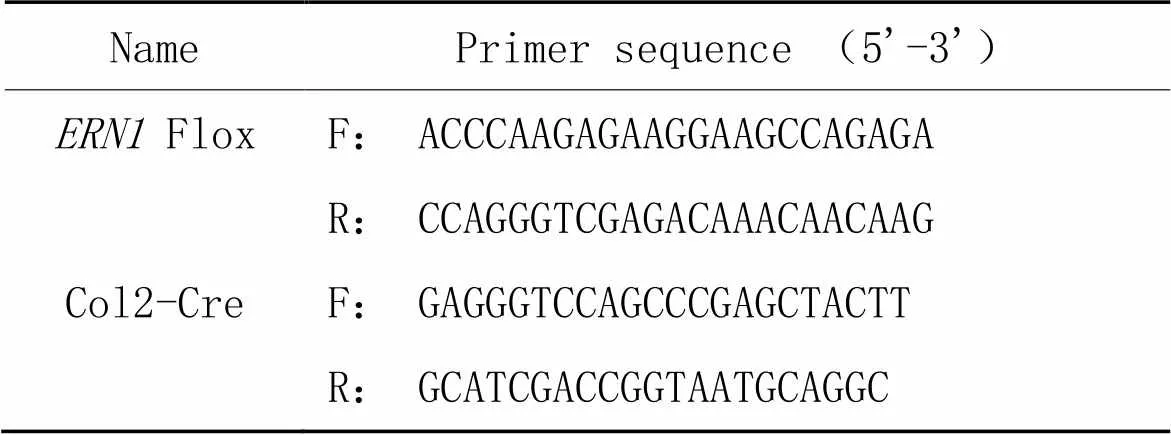
表1 小鼠ERN1基因型鉴定引物
F: forward; R: reverse.
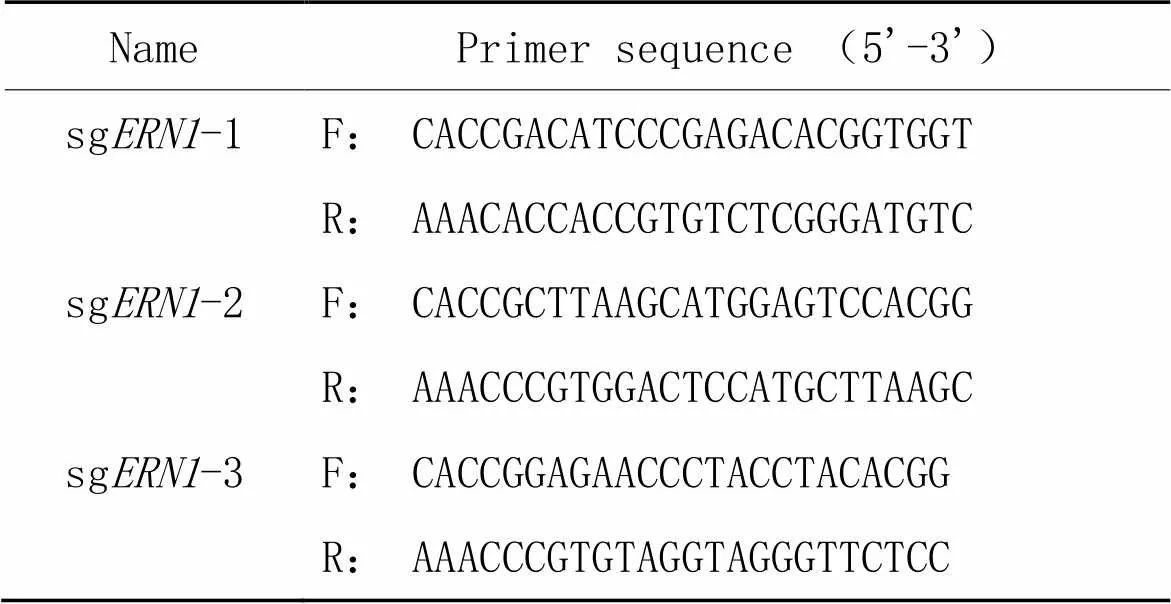
表2 CRISPR-Cas9 oligo引物
F: forward; R: reverse.
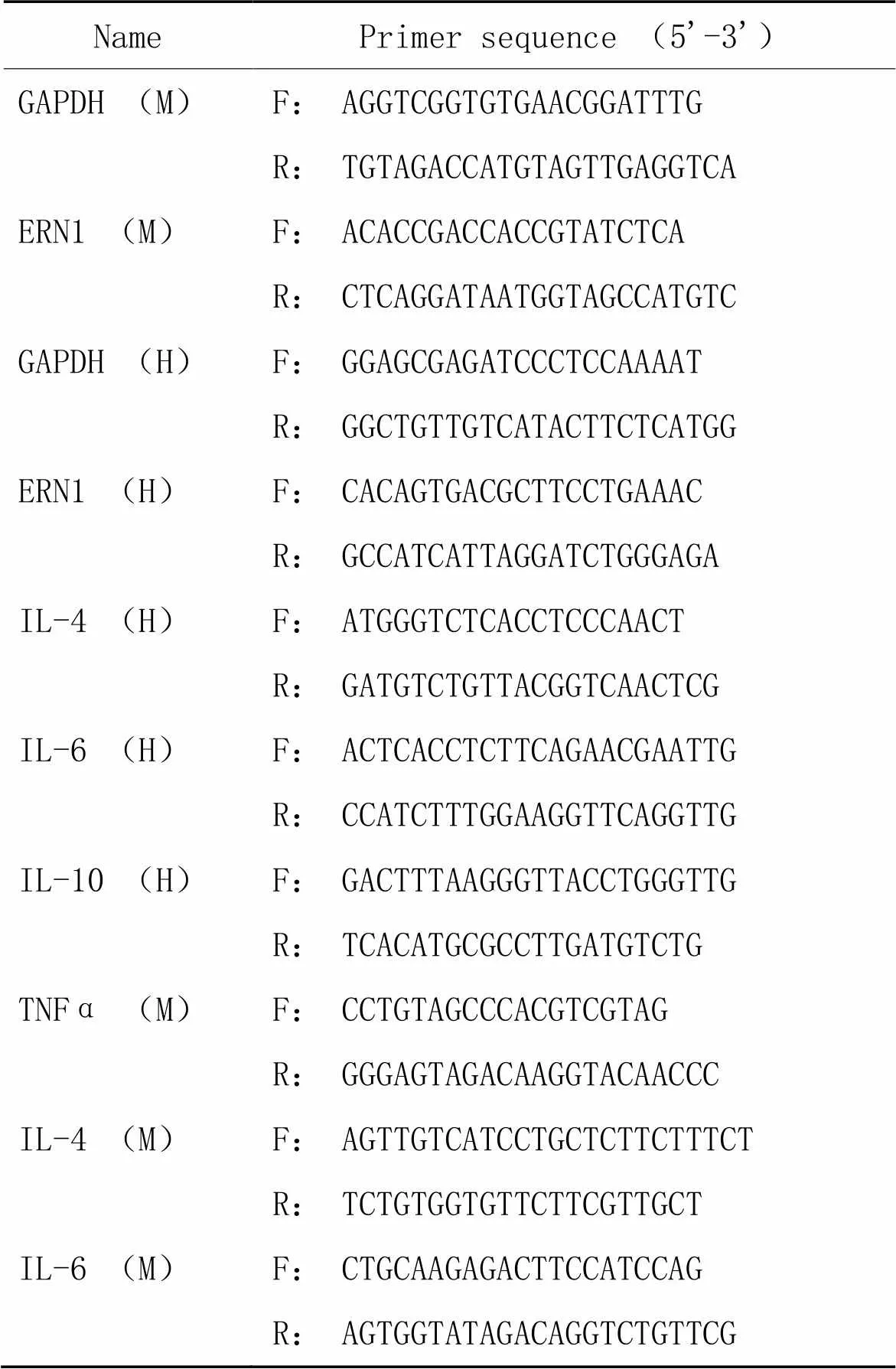
表3 qPCR引物
M: mouse; F: forward; R: reverse; H: human.
4 主要方法
4.1构建C28/I2细胞敲除稳定细胞株(1)LentiCRISPR-sg质粒构建:将合成的oligo引物正反义链退火形成双链DNA,T4 PNK酶加磷;BsmBI内切酶酶切lentiCRISPRv2质粒,质粒长度为14 873 bp,酶切后CIP酶去磷酸化,凝胶电泳弃掉约2 kb的小片段,胶回收纯化大片段;T4 DNA连接酶连接4 ℃过夜;STBL3感受态转化涂板;挑取单克隆菌摇菌,测序;(2)慢病毒包装:将测序正确的质粒进行293T细胞慢病毒包装,包装质粒比例为LentiCRISPR-sgRNA∶psPAX2∶VSVG=3∶2∶1,以Lenti-GFP为包装效率阳性对照,PEI辅助转染;收集72~96 h病毒上清;(3)筛选敲除稳定细胞株:感染C28/I2细胞,以Lenti-GFP感染为阳性对照,polybrene辅助感染;0.5 mg/L puromycin筛选,当C28/I2空细胞杀死完后,收取部分感染慢病毒的细胞进行Western blot鉴定,将有明显敲低效果的细胞进行单克隆细胞株筛选,Western blot鉴定敲除效果。
4.2小鼠基因型鉴定剪取2~3周待鉴定小鼠脚趾,提取基因组;以基因组为模板,分别用flox引物和Col2-Cre引物进行PCR扩增;2%琼脂糖凝胶电泳;基因型结果判读:野生型只有361 bp一条带,flox/+杂合子有361、486 bp两条带,flox/flox纯合子只有486 bp一条带;Col2-Cre阳性有300 bp条带,阴性则无条带。
4.3分离小鼠原代软骨细胞收集新生6 d的flox/flox对照(control)小鼠和flox/flox-Col2Cre特异性敲除(cKO)小鼠;取下膝关节软骨;PBS清洗;1 g/L Ⅱ型胶原酶37 ℃消化12~16 h;加含10%血清、1%青链霉素的DMEM/F12培养基培养,48 h换液传代。
4.4qPCR(1)过表达:接种C28/I2细胞,待细胞贴壁后,分别加入最适滴度的AdGFP(对照组)和Ad(过表达组),polybrene辅助感染,感染5 h后更换新鲜的完全培养基培养;此外,根据实验在细胞感染AdGFP和Ad腺病毒5 h换液时,分别加IL-1β使终浓度为10 μg/L模拟细胞炎症微环境;(2)敲除:接种敲除的C28/I2细胞(KO1和KO2)及对照(parental);接种小鼠原代软骨细胞(对照组)和cKO小鼠原代软骨细胞(NER/cKO组);待细胞贴壁,分别加IL-1β使终浓度为10 μg/L模拟细胞炎症微环境。收集IL-1β作用36 h后的细胞,Trizol法提取RNA,参照试剂盒说明书逆转录为cDNA,进行qPCR测定。
4.5Western blot细胞处理方法同qPCR;收集IL-1β作用 48 h的细胞,RIPA裂解液提取细胞蛋白;SDS-PAGE胶分离,220 mA恒流,1 KD/min转移目的蛋白至PVDF膜,5% BSA室温封闭1 h, GAPDH(1∶8 000)及其余Ⅰ抗(1∶1 000)4 ℃孵育过夜,TBST洗膜,孵育Ⅱ抗羊抗兔(1∶10 000)室温2 h,洗膜,ECL显影。
4.6前交叉韧带切除(anterior cruciate ligament transection, ACLT)术随机选取8~10周龄的雄性小鼠flox/flox(control)和flox/flox-Col2Cre(cKO)各6只,麻醉,膝关节处脱毛,剪开膝关节处皮肤暴露关节腔,手术组切断前交叉韧带,髌韧带复位,缝合,消毒伤口。假手术(sham)组,不切断前交叉韧带,其余方法同手术组。
4.7免疫组化cKO和control小鼠ACLT术后8周的膝关节石蜡切片进行脱蜡水化;抗原修复,复合消化液37 ℃,30 min;加辣根过氧化物酶阻断剂室温孵育10 min;正常山羊血清封闭;加入Ⅰ抗(1∶200),4 ℃孵育过夜;孵育生物素标记羊抗兔/鼠Ⅱ抗(37 ℃、1 h);HRP标记链霉卵白素工作液室温孵育15 min;DAB显色;脱水,封片,镜检。
5 统计学处理
应用Graphpad Prism 6软件进行统计学分析,计量资料以均数±标准差(mean±SD)表示。两组间的比较采用检验,多组间的比较采用单因素方差分析,以<0.05认为差异有统计学意义。
结果
1 人ERN1基因敲除C28/I2稳定细胞株的构建和鉴定
LentiCRISPRv2载体经B I酶切线性化,切下约2.0 kb片段,见图1A;弃掉小片段DNA,胶回收获得大片段DNA,见图1B;与退火的寡聚核苷酸双链连接,转化,挑菌,测序,成功将3条sgRNA逐一连接至载体,测序结果,见图1C;以Lenti-GFP质粒为对照,293T细胞包装慢病毒,包装96 h时细胞荧光,见图1D;收集慢病毒上清,感染C28/I2人软骨细胞,感染48 h时细胞荧光,见图1E;经嘌呤霉素筛选得到基因敲低细胞株,Western blot结果显示sg1#、sg2#有显著敲低效果,见图1F;进一步经过多轮单克隆细胞株筛选,成功获得KO1、KO2敲除细胞株,Western blot鉴定结果,见图1G。
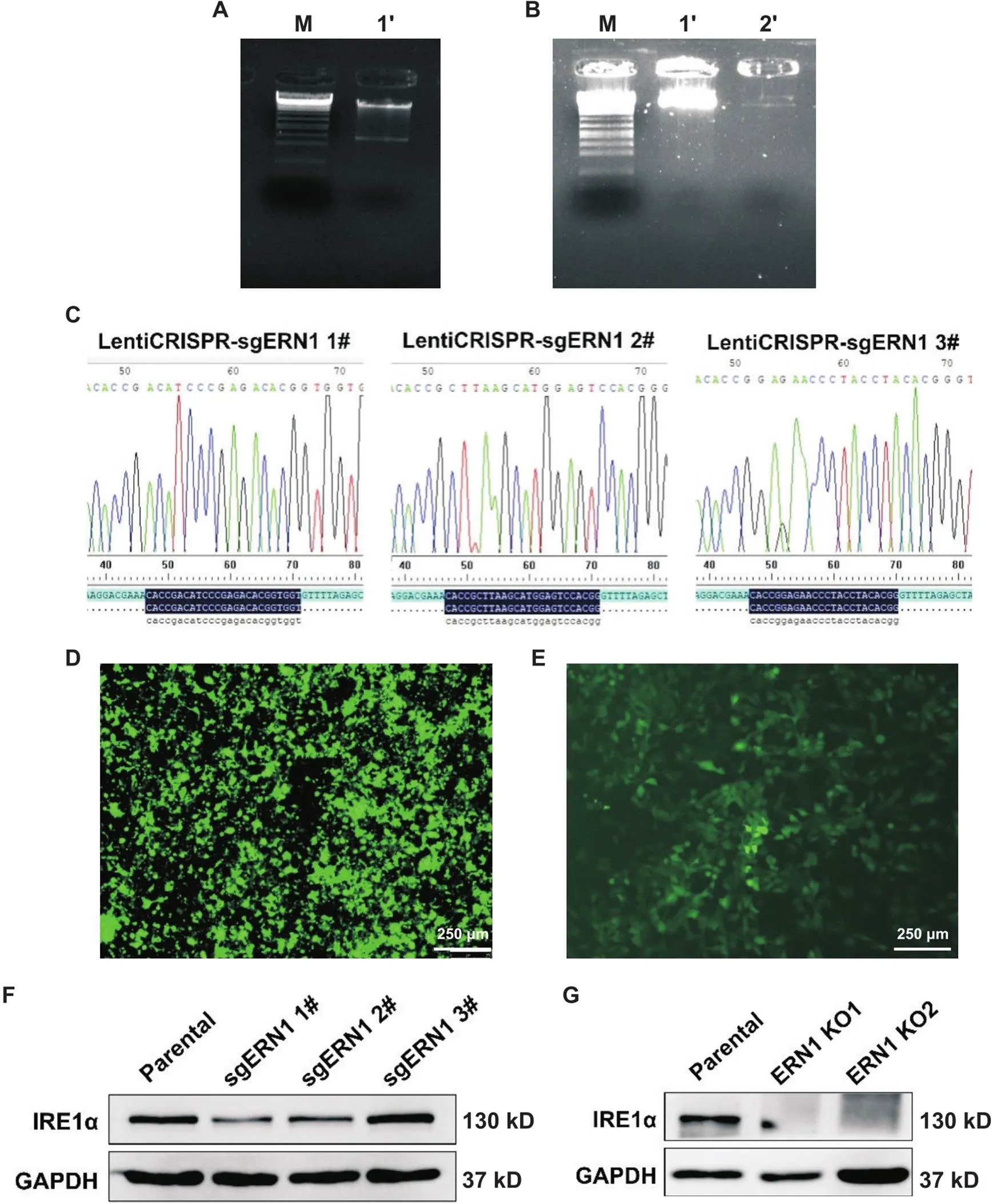
Figure 1. Construction and screening of stable cell lines with specific ERN1 knockout in C28/I2 cells using CRISPR-Cas9 technology. A: the result of restriction enzyme digestion of LentiCRISPRv2 (M: λ-EcoT14 I/Bgl II digest DNA marker; 1: LentiCRISPRv2 digested by BsmB I); B: the result of gel purification (M: DNA marker; 1': LentiCRISPRv2 plasmid without digestion; 2': result of gel purification of larger band); C: DNA sequence of LentiCRISPRv2-sgRNA plasmids; D: packaging of lentivirus positive control lenti-GFP in 293T cells; E: infection of Lenti-GFP supernatant in C28/I2 cells; F: ERN1 knockdown effect with puromycin screening was identified using Western blot in C28/I2 cells; G: Western blot confirmation of ERN1 knockout in C28/I2 cells.
2 ERN1敲除C28/I2软骨细胞中抗炎因子水平降低、致炎因子水平升高
采用不同浓度梯度IL-1β处理C28/I2细胞不同时间,Western blot结果显示,随着IL-1β浓度增加,IRE1α表达也随之增加;在10 μg/L IL-1β诱导C28/I2细胞36 h、48 h时,IRE1α蛋白表达显著增加(<0.01),见图2。同时IL-1β处理敲除基因的C28/I2软骨细胞稳定细胞株,其qPCR结果显示,与Parental细胞比较,IL-1β诱导时,敲除明显抑制抗炎因子IL-4、IL-10的mRNA水平(<0.01),促进致炎因子IL-6的mRNA水平(<0.01),见图3A。Western blot结果显示,敲除C28/I2软骨细胞与对照Parental比较,无IL-1β诱导时,TNFα蛋白表达无明显差异;但在IL-1β诱导时,敲除细胞株KO1+IL-1β、ERN1 KO2+IL-1β组TNFα表达显著升高(<0.05),见图3B、C。
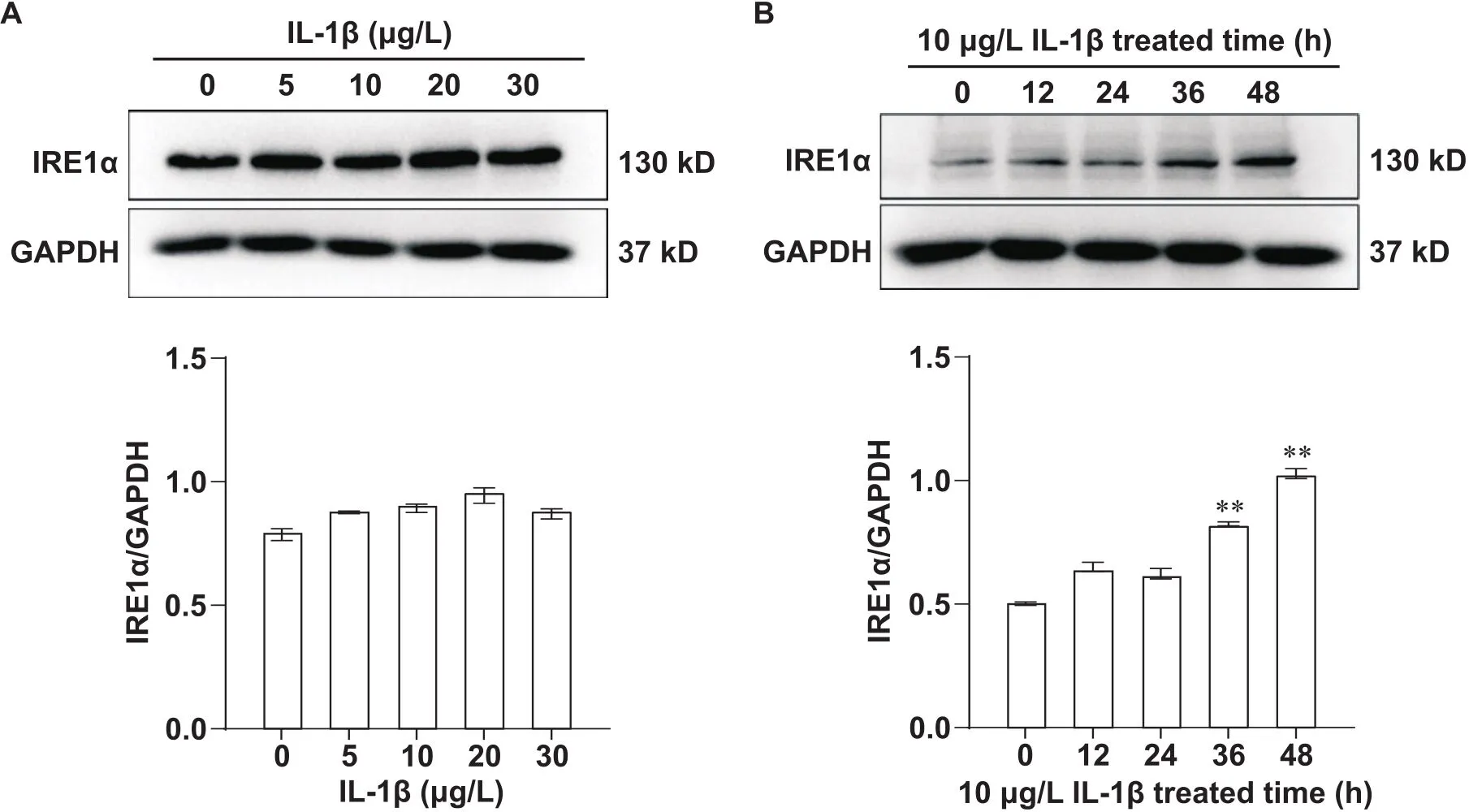
Figure 2. Expression changes of IRE1α in C28/I2 cells treated with different concentrations of IL-1β for 24 h (A) or with 10 μg/L IL-1β for different time (B) were detected by Western blot. Mean±SD. n=3.**P<0.01 vs 0 h group.

Figure 3. The mRNA and protein levels of ERN1 and inflammatory factors in ERN1-deficient C28/I2 chondrocytes were detected. A: the mRNA levels of ERN1, IL-4, IL-10 and IL-6 detected by qPCR; B: the protein level of TNFα in cells without IL-1β stimulation detected by Western blot; C: the protein level of TNFα in IL-1β-induced ERN1 knockout C28/I2 cells detected by Western blot. Mean±SD. n=3. *P<0.05, **P<0.01 vs parental+IL-1β group.
3 ERN1 cKO小鼠原代软骨细胞中致炎因子升高、抗炎因子降低
分离缺陷小鼠原代软骨细胞,IL-1β处理,qPCR结果显示,与对照组相比,缺陷显著增强TNFα、IL-6 mRNA水平(<0.01),抑制IL-10的mRNA水平(<0.05),见图4A。Western blot结果显示,未加IL-1β处理,正常生理条件下control组与cKO组TNFα表达无明显差异,而在IL-1β诱导时,cKO显著上调TNFα蛋白表达(<0.05),见图4B、C。
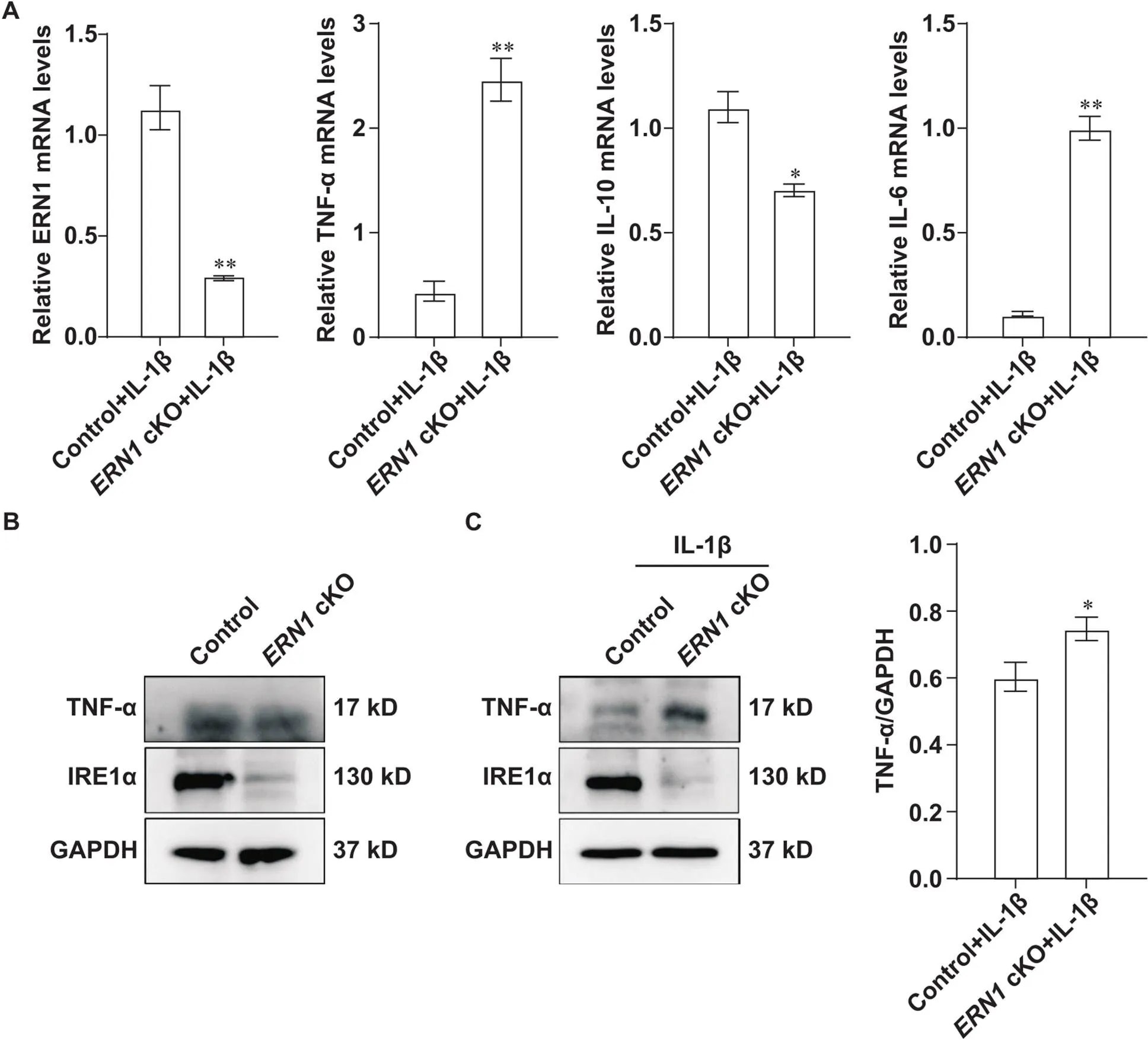
Figure 4. The mRNA and protein levels of ERN1 and inflammatory factors in ERN1 cKO mouse primary chondrocytes were detected. A: the mRNA levels of ERN1, TNFα, IL-10 and IL-6 in IL-1β-induced ERN1 cKO mouse primary chondrocytes were detected by qPCR; B: the protein levels of TNFα were detected by Western blot in primary chondrocytes without IL-1β stimulation; C: the protein levels of TNFα in IL-1β-induced ERN1 cKO mouse primary chondrocytes were detected by Western blot. Mean±SD. n=3. *P<0.05, **P<0.01 vs control+IL-1β group.
4 软骨细胞中ERN1过表达上调抗炎因子、下调致炎因子
在C28/I2细胞中转染腺病毒(Ad),AdGFP为对照。软骨细胞经IL-1β处理,qPCR结果显示,与AdGFP组比较,过表达显著上调IL-4和IL-10 mRNA水平(<0.05),下调IL-6 mRNA水平(<0.01),见图5。Western blot结果显示,过表达在IL-1β处理前后都会抑制TNFα蛋白表达,且在IL-1β诱导后,Ad抑制TNFα表达更显著(<0.01),见图6。
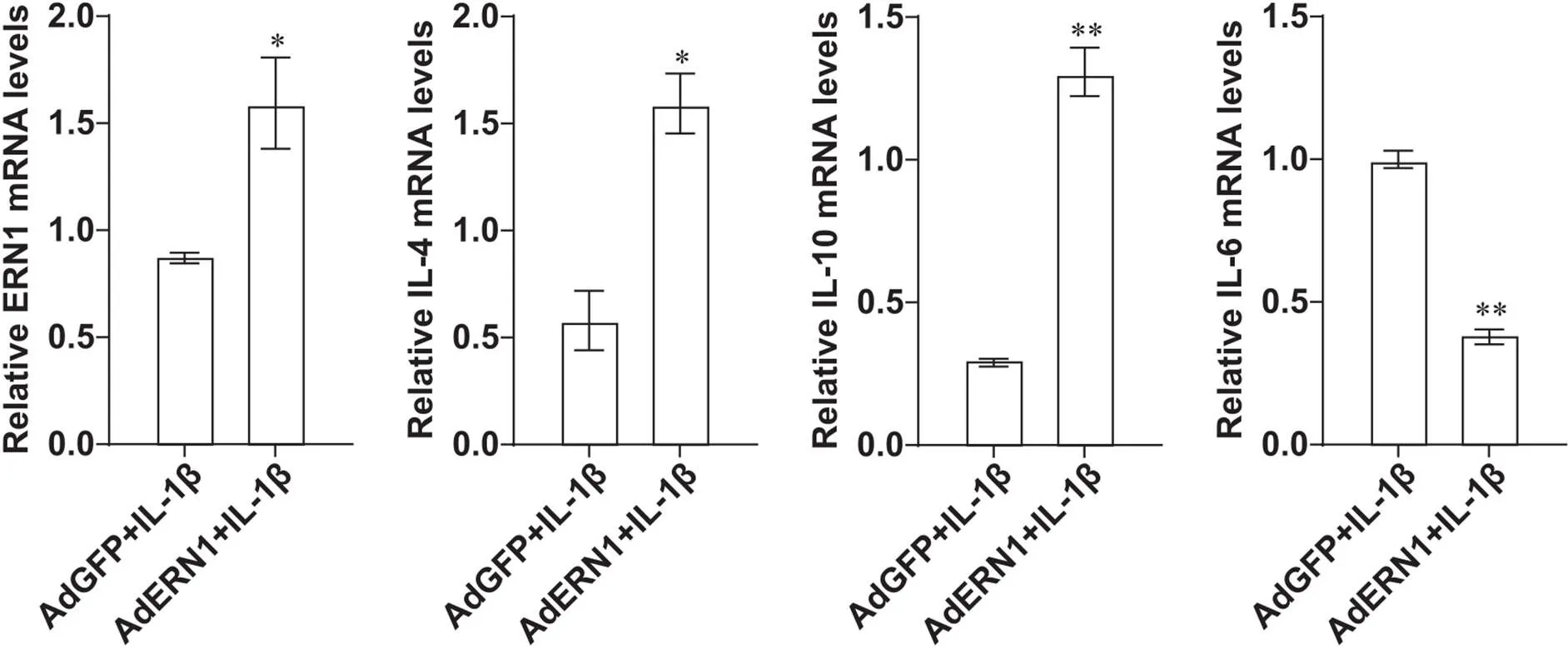
Figure 5. The mRNA levels of ERN1 and inflammatory factors IL-4, IL-10 and IL-6 were detected by qPCR after over-expression of ERN1 in IL-1β-induced C28/I2 cells. Mean±SD. n=3. *P<0.05, **P<0.01 vs AdGFP+IL-1β group.
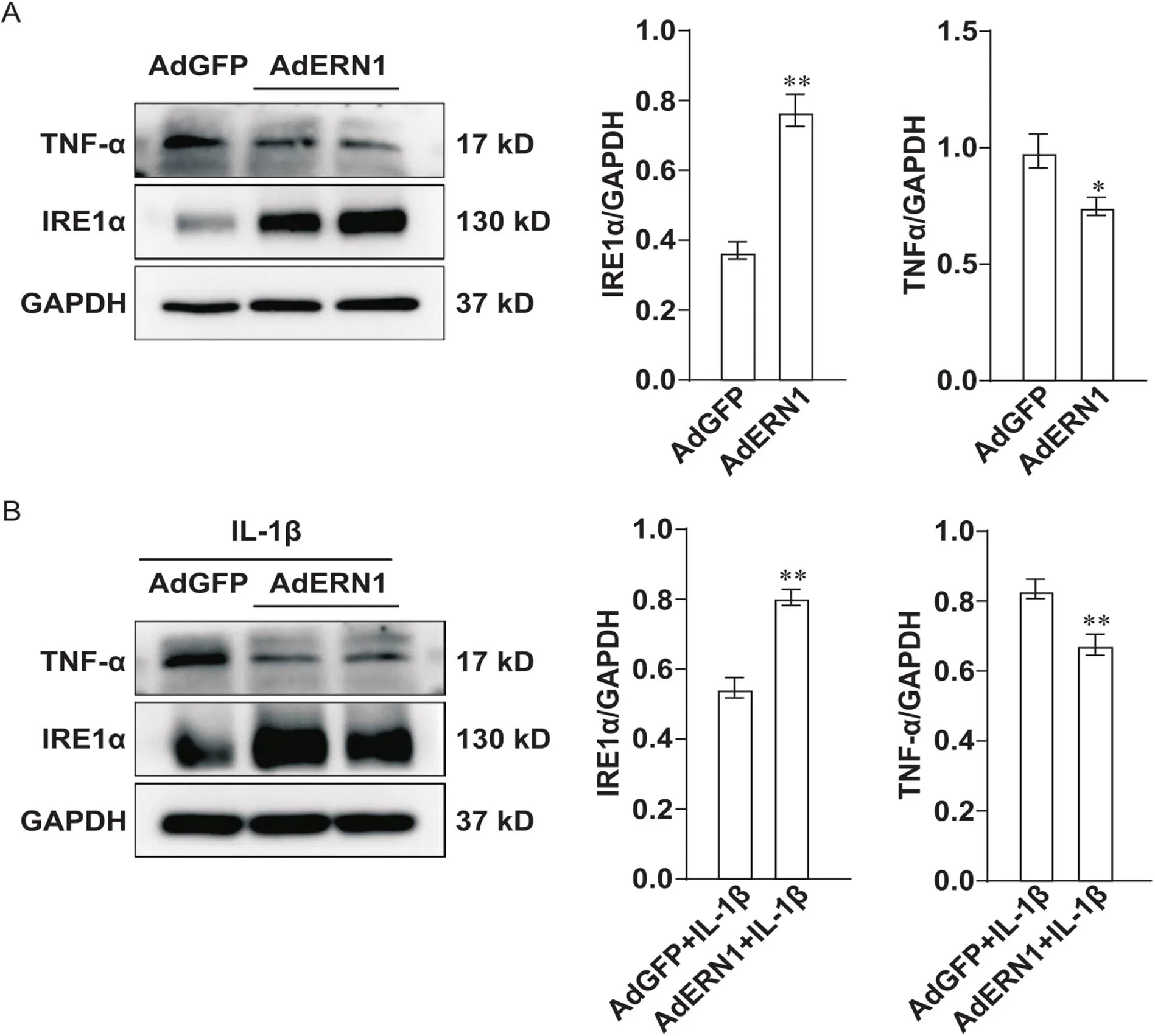
Figure.6. The protein levels of IRE1α and TNFα were detected after over-expression of ERN1. A: the protein levels of IRE1α and TNFα were detected by Western blot after over-expression of ERN1 without IL-1β stimulation; B: the protein levels of IRE1α and TNFα were detected by Western blot after overexpression of ERN1 in IL-1β-induced C28/I2 cells. Mean±SD. n=3. *P<0.05, **P<0.01 vs AdGFP+IL-1β group.
5 ERN1缺陷C28/I2软骨细胞中,IL-1β促进软骨分解代谢
收集缺陷C28/I2软骨细胞KO1、KO2和对照parental细胞蛋白进行Western blot检测,结果显示,无IL-1β处理时,parental和KO1、KO2细胞的分解代谢标志物MMP13、ADAMTS5表达无明显差异,且蛋白表达量低,见图7A;而细胞在IL-1β处理后,与parental组比较,缺陷显著上调MMP13和ADAMTS5的蛋白表达水平(<0.05),见图7B。

Figure 7. The protein levels of ADAMTS5 and MMP13 in ERN1-deficient C28/I2 chondrocytes were detected. A: the protein levels of MMP13 and ADAMTS5 in ERN1 knockout C28/I2 cells were detected by Western blot without IL-1β stimulation; B: the protein levels of MMP13 and ADAMTS5 in IL-1β-induced ERN1 knockout C28/I2 cells were detected by Western blot. Mean±SD. n=3.**P<0.01 vs parental+IL-1β group.
6 ERN1 cKO小鼠原代软骨细胞中,IL-1β上调分解代谢
收集缺陷小鼠原代软骨细胞cKO和对照小鼠原代软骨细胞蛋白,Western blot结果显示,无IL-1β处理时,与control组相比,cKO组的ADAMTS5差异不显著,MMP13表达显著降低,见图8A;在IL-1β处理后,cKO细胞MMP13和ADAMTS5的蛋白表达水平显著上调(<0.05),见图8B。
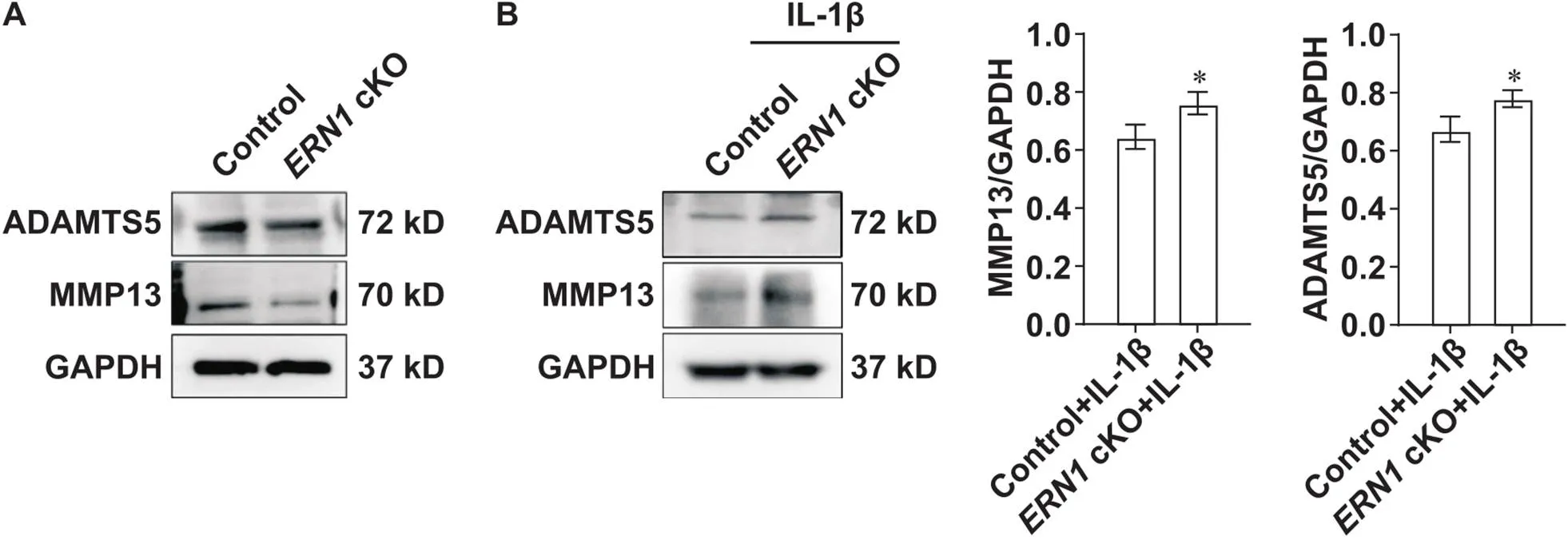
Figure 8. The protein levels of ADAMTS5 and MMP13 in ERN1 cKO mouse primary chondrocytes were detected. A: the protein levels of MMP13 and ADAMTS5 in ERN1 cKO mouse primary chondrocytes without IL-1β stimulation were detected by Western blot; B: the protein levels of MMP13 and ADAMTS5 in IL-1β-induced ERN1 cKO mouse primary chondrocytes were detected by Western blot. Mean±SD. n=3. *P<0.05 vs control+IL-1β group.
7 ERN1缺陷对小鼠骨关节炎软骨的影响
收集ACLT术后8周的cKO和control小鼠膝关节,进行石蜡切片。免疫组化染色结果显示,与control小鼠相比,cKO组IL-1β和TNFα表达水平显著升高(<0.01),见图9。

Figure 9. The expression and distribution of IL-1β (A) and TNFα (B) in the articular cartilage of control and ERN1 cKO mice for 8 weeks after ACLT modeling were detected by immunohistochemistry and the proportion of positive cells was quantified. Mean±SD. n=3. **P<0.01 vs control group.
讨论
关节软骨细胞由于年龄、肥胖、炎症、代谢障碍、创伤、劳损、遗传等因素所引发的炎症是诱发骨关节炎的首要因素,炎症因子与软骨细胞、胞外基质蛋白和细胞粘附分子之间的一系列复杂精细的调控与骨关节炎等相关疾病的发生密切相关。研究表明炎症与UPR在许多方面存在联系。UPR与细胞内炎症反应信号通路的偶联是引发炎症反应的主要原因之一,也是许多炎症疾病的发病机制和病理基础[12]。ERS已被证实与多种疾病的发生、发展有关,包括OA[13]、类风湿性关节炎[14]和其他炎症性疾病[15-16]。IRE1α作为UPR的经典传感器,在不同的生物体、组织和疾病中具有多样化功能。在肿瘤细胞中,抑制IRE1α活性可降低肿瘤细胞增殖并增加乳腺癌、结肠直肠癌和肝癌等各种癌症类型的化学敏感性[17-19]。骨髓特异性缺失f/f,Lyz2-Cre小鼠在很大程度上逆转高脂肪饮食诱导的白色脂肪组织中的M1-M2极化失衡,并阻断高脂饮食诱导的肥胖、胰岛素抵抗、高脂血症和肝脂肪变性[20]。IRE1α激活的ERS和机体免疫细胞中的UPR信号通路IRE1α可以增加炎症细胞因子的释放,进一步促进炎症的产生[21-22]。但IRE1α在软骨细胞中的功能与作用却很少报道,本研究探讨了/IRE1α在炎症微环境中与软骨细胞炎症因子和软骨分解代谢的关系,为后续深入解读IRE1α在软骨细胞的功能奠定基础。
IL-1β是一种重要的致炎细胞因子,在软骨降解与软骨相关疾病中起着重要作用。IL-1β诱导促进诸如IL-6、TNFα等促炎细胞因子的表达和蛋白分泌,这可能导致对软骨细胞的继发性损伤[23]。OA病理生物学的主要特征是软骨损伤伴随促炎细胞因子水平升高[24]。另一方面,IL-4和IL-10是多效性细胞因子,可通过负性调节自分泌和旁分泌反馈环抑制促炎环境,并参与软骨细胞的保护[25-26]。
在这项研究中,我们探讨了对炎症微环境中软骨细胞炎症因子和软骨分解代谢的影响。首先通过Western blot实验发现,在生理条件下,软骨细胞缺陷,没有引起TNFα的蛋白变化;但在IL-1β诱导下,软骨细胞缺陷显著促进TNFα的表达;同时在mRNA水平也验证这一作用,缺陷的C28/I2软骨细胞和软骨特异性缺失的小鼠原代软骨细胞在炎症微环境中,发现软骨缺失能促进TNFα和IL-6的表达,抑制IL-4和IL-10表达;反之,在软骨细胞中过表达,抑制促炎细胞因子表达,促进抗炎细胞因子表达;并在ACLT诱导的小鼠OA模型中发现ERN1软骨缺陷会导致TNFα和IL-1β显著升高。以上结果表明,对于炎症微环境中的软骨细胞具有保护作用。
研究报道,抑制MMPs产生可以抑制软骨降解的进展[27-28]。在关节软骨中,IL-1β能够增加MMPs的释放及胶原蛋白和蛋白聚糖的降解[29]。此外,ADAMTS也是OA中重要的蛋白质水解产物,尤其是ADAMTS4和ADAMTS5,它们负责裂解聚集蛋白聚糖[30]。因此,靶向MMPs、ADAMTS的个体化治疗代表了一种有希望的OA潜在治疗策略。在本研究中,我们通过敲除基因,检测MMP13和ADAMTS5的表达,发现缺陷可以促进人正常软骨细胞和小鼠原代软骨细胞IL-1β诱导的软骨分解代谢标志物MMP13、ADMATS5的表达。结果表明,缺陷可以促进炎症微环境中软骨细胞分解代谢。
综合上述结果,过表达对炎症微环境中的软骨细胞具有抗炎保护作用,缺陷对软骨细胞炎症微环境具有促炎和促进软骨分解代谢的多重作用。通过调节炎症因子的敏感性,参与炎症反应。本研究初步阐明软骨细胞中/IRE1α参与炎症微环境的可能机制,为进一步探究/IRE1α与OA及炎症相关疾病的关系奠定基础。
[1] Lee HP, Gu L, Mooney DJ, et al. Mechanical confinement regulates cartilage matrix formation by chondrocytes[J]. Nat Mater, 2017, 16(12):1243-1251.
[2] Mobasheri A, Rayman MP, Gualillo O, et al. The role of metabolism in the pathogenesis of osteoarthritis[J]. Nat Rev Rheumatol, 2017, 13(5):302-311.
[3] Riewruja K, Phakham S, Sompolpong P, et al. Cytokine profiling and intra-articular injection of autologous platelet-rich plasma in knee osteoarthritis[J]. Int J Mol Sci, 2022, 23(2):890.
[4] Scott KM, Cohen DJ, Hays M, et al. Regulation of inflammatory and catabolic responses to IL-1β in rat articular chondrocytes by microRNAs miR-122 and miR-451[J]. Osteoarthritis Cartilage, 2021, 29(1):113-123.
[5] Bollmann M, Pinno K, Ehnold LI, et al. MMP-9 mediated Syndecan-4 shedding correlates with osteoarthritis severity[J]. Osteoarthritis Cartilage, 2021, 29(2):280-289.
[6]卓泽铭, 范忠诚, 郭祥. 桑寄生提取物联合miR-375对骨关节炎软骨细胞活力和凋亡的影响[J]. 中国病理生理杂志, 2020, 36(6):1082-1088.
Zhuo ZM, Fan ZC, Guo X. Effect of Herba Taxilli extracts combined with miR-375 on viability and apoptosis of osteoarthritic chondrocytes[J]. Chin J Pathophysiol, 2020, 36(6):1082-1088.
[7] You K, Wang L, Chou CH, et al. QRICH1 dictates the outcome of ER stress through transcriptional control of proteostasis[J]. Science, 2021, 371(6524):eabb6896.
[8] Mogilenko DA, Haas JT, L'Homme L, et al. Metabolic and innate immune cues merge into a specific inflammatory response via the UPR[J]. Cell, 2019, 177(5):1201-1216.e19.
[9] Hetz C, Zhang K, Kaufman RJ. Mechanisms, regulation and functions of the unfolded protein response[J]. Nat Rev Mol Cell Biol, 2020, 21(8):421-438.
[10] Huang R, Hui Z, Wei S, et al. IRE1 signaling regulates chondrocyte apoptosis and death fate in the osteoarthritis[J]. J Cell Physiol, 2022, 237(1):118-127.
[11] Mullan LA, Mularczyk EJ, Kung LH, et al. Increased intracellular proteolysis reduces disease severity in an ER stress-associated dwarfism[J]. J Clin Invest, 2017, 127(10):3861-3865.
[12] 郜婕, 唐成林, 刘仁建, 等. 不同强度电针对肥胖大鼠附睾脂肪细胞内质网应激的影响[J]. 中国病理生理杂志, 2013, 29(2):354-357.
Cao J, Tang CL, Liu RJ, et al. Effect of electroacupuncture in different intensities on endoplasmic reti-culum stress in adipose tissues from high-fat diet-induced obese rats [J]. Chin J Pathophysiol, 2013, 29(2):354-357.
[13] Lee SY, Wong PF, Jamal J, et al. Naturally-derived endoplasmic reticulum stress inhibitors for osteoarthritis?[J]. Eur J Pharmacol, 2022, 922:174903.
[14] Barrera MJ, Aguilera S, Castro I, et al. Dysfunctional mitochondria as critical players in the inflammation of autoimmune diseases: potential role in Sjögren's syndrome[J]. Autoimmun Rev, 2021, 20(8):102867.
[15] Liu N, Bai L, Lu Z, et al. TRPV4 contributes to ER stress and inflammation: implications for Parkinson's disease[J]. J Neuroinflammation, 2022, 19(1):26.
[16] 敖文, 徐在革, 白杨, 等. 基于内质网应激-自噬通路研究茯苓多糖对2型糖尿病小鼠肠道屏障功能损伤和炎症反应的影响[J]. 中国病理生理杂志, 2022, 38(5):829-838.
Ao W, Xu ZG, Bai Y, et al. Poria cocos polysaccharide improves intestinal barrier function and attenuates inflammatory response in type 2 diabetic mice through endoplasmic reticulum stress-autophagy pathway[J]. Chin J Pathophysiol, 2022, 38(5):829-838.
[17] Logue SE, McGrath EP, Cleary P, et al. Inhibition of IRE1 RNase activity modulates the tumor cell secretome and enhances response to chemotherapy[J]. Nat Commun, 2018, 9(1):3267.
[18] Fang P, Xiang L, Huang S, et al. IRE1α-XBP1 signaling pathway regulates IL-6 expression and promotes progression of hepatocellular carcinoma[J]. Oncol Lett, 2018, 16(4):4729-4736.
[19] Jin C, Jin Z, Chen NZ, et al. Activation of IRE1α-XBP1 pathway induces cell proliferation and invasion in colorectal carcinoma[J]. Biochem Biophys Res Commun, 2016, 470(1):75-81.
[20] Shan B, Wang X, Wu Y, et al. The metabolic ER stress sensor IRE1α suppresses alternative activation of macrophages and impairs energy expenditure in obesity[J]. Nat Immunol, 2017, 18(5):519-529.
[21] Keestra-Gounder AM, Byndloss MX, Seyffert N, et al. NOD1 and NOD2 signalling links ER stress with inflammation[J]. Nature, 2016, 532(7599):394-397.
[22] Kim S, Joe Y, Kim HJ, et al. Endoplasmic reticulum stress-induced IRE1α activation mediates cross-talk of GSK-3β and XBP-1 to regulate inflammatory cytokine production[J]. J Immunol, 2015, 194(9):4498-4506.
[23] Eugene SP, Reddy VS, Trinath J. Endoplasmic reticulum stress and intestinal inflammation: a perilous union[J]. Front Immunol, 2020, 11:543022.
[24] Katz JN, Arant KR, Loeser RF. Diagnosis and treatment of hip and knee osteoarthritis: a review[J]. JAMA, 2021, 325(6):568-578.
[25] Moss KL, Jiang Z, Dodson ME, et al. Sustained interleukin-10 transgene expression following intra-articular AAV5-IL-10 administration to horses[J]. Hum Gene Ther, 2020, 31(1/2):110-118.
[26] Song SY, Hong J, Go S, et al. Interleukin-4 gene transfection and spheroid formation potentiate therapeutic efficacy of mesenchymal stem cells for osteoarthritis[J]. Adv Healthc Mater, 2020, 9(5):e1901612.
[27] Schultz C. Targeting the extracellular matrix for delivery of bioactive molecules to sites of arthritis[J]. Br J Pharmacol, 2019, 176(1):26-37.
[28] 贺自克, 王上增, 沈锦涛. 基于Hedgehog通路探讨补肾活血方对实验性膝骨性关节炎兔退变软骨的保护作用[J]. 中国病理生理杂志, 2020, 36(4):700-706.
He ZK, Wang SZ, Shen JT. Protective effect of Bushen-Huoxue prescription on degenarative carti-lage in rabbits with experimental knee osteoarthritis based on Hedgehog pathway[J]. Chin J Pathophysiol, 2020, 36(4):700-706.
[29] Liu J, Cao L, Gao X, et al. Ghrelin prevents articular cartilage matrix destruction in human chondrocytes[J]. Biomed Pharmacother, 2018, 98:651-655.
[30] Rogerson FM, Last K, Golub SB, et al. ADAMTS-9 in mouse cartilage has aggrecanase activity that is distinct from ADAMTS-4 and ADAMTS-5[J]. Int J Mol Sci, 2019, 20(3):573.
Regulatory effect of ERN1 on biological properties of chondrocytes in an inflammatory microenvironment
LIANG Li, DENG Lin, LUO Rui, FENG Naibo, LI Xiaoli, FAN Mengtian, GUO Fengjin△
(,,400016,)
To explore the effect of endoplasmic reticulum-to-nucleus signaling 1 () gene on the biological properties of chondrocytes in an inflammatory microenvironment.Theknockout C28/I2 human normal chondrocyte cell lineKO was constructed by CRISPR-Cas9 system. Primary chondrocytes fromcartilage-specific knockout mice with C57BL/6J background were isolated, and the experiments were divided into control group (flox/flox),cKO group (flox/flox-Col2Cre+).adenovirus (Ad) was over-expressed in C28/I2 human normal chondrocytes, with AdGFP as the control group. Interleukin-1β (IL-1β) at 10 μg/L was used in chondrocytes to form an inflammatory microenvironment. The expression of inflammatory factors tumor necrosis factor α (TNFα), IL-4, IL-6 and IL-10, and cartilage catabolism markers matrix metalloproteinase 13 (MMP13) and a disintegrin and metalloproteinase with thrombospondin motifs 5 (ADAMTS5) in chondrocytes afterdeletion or overexpression in the inflammatory microenvironment induced by IL-1β was detected by qPCR and Western blot.ThesgRNA was successfully constructed into LentiCRISPRv2 vector, andknockout stable cell line were successfully screened in C28/I2 cells. qPCR results showed that in the inflammatory microenvironment,deficiency up-regulated the mRNA levels of pro-inflammatory cytokines IL-6 and TNFα in chondrocytes (<0.05), and down-regulated the mRNA levels of anti-inflammatory cytokines IL-4 and IL-10 (<0.05). Western blot results showed that when chondrocytes were in the inflammatory microenvironment,deficiency significantly up-regulated the expression of pro-inflammatory cytokine TNFα (<0.05), and enhanced the expression of cartilage catabolism markers ADAMTS5 and MMP13 (<0.05). The expression of TNFα was significantly inhibited after over-expression of(<0.05).regulates the inflammatory sensitivity of chondrocytes by regulating the levels of pro-inflammatory and anti-inflammatory factors, and then participates in the inflammatory response.
gene; inflammatory factors; chondrocytes; cartilage catabolism
R329.2; R363.2+1
A
10.3969/j.issn.1000-4718.2023.02.014
1000-4718(2023)02-0314-11
2022-08-22
2022-11-01
[基金项目]国家自然科学基金资助项目(No. 81871769);重庆市科委面上项目(No. cstc2020jcyj-msxmX0175);重庆市科委博士后科学基金项目(No. cstc2021jcyj-bshX0214);重庆医科大学研究生拔尖人才培育项目(No. BJRC202019)
Tel: 15310288670; E-mail: guo.fengjin@cqmu.edu.cn
(责任编辑:余小慧,李淑媛)

